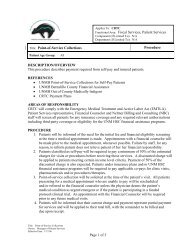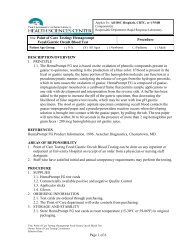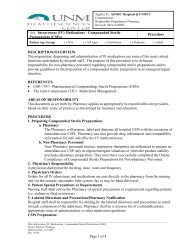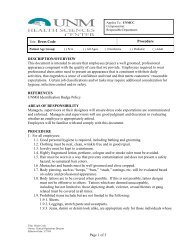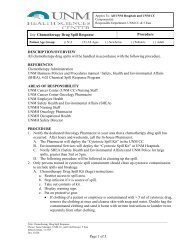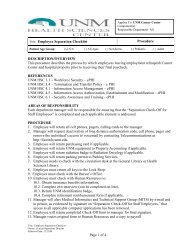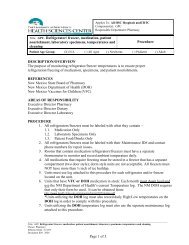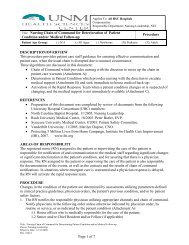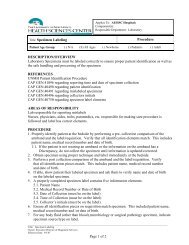Page 1 of 25 DESCRIPTION/OVERVIEW The purpose of this ...
Page 1 of 25 DESCRIPTION/OVERVIEW The purpose of this ...
Page 1 of 25 DESCRIPTION/OVERVIEW The purpose of this ...
You also want an ePaper? Increase the reach of your titles
YUMPU automatically turns print PDFs into web optimized ePapers that Google loves.
ATTACHMENT E: VENOUS ACCESS PORT ADDENDUM<br />
1. Identify the correct patient. Confirm gauge and needle length <strong>of</strong> non-coring (Huber) needle.<br />
2. Explain the procedure to the patient/parent using age appropriate language.<br />
3. Approximately 45-60 minutes prior to accessing the infusaport/PASport apply a layer <strong>of</strong> EMLA cream over the site. Cover with bio-occlusive dressing.<br />
4. After the allotted time, prepare to access the infusaport/PASport using the appropriate size non-coring (Huber) needle.<br />
5. Remove the bio-occlusive dressing from the patient. Remove all remaining EMLA from the site with a dry 4 x 4 gauze.<br />
6. Allow the patient to assume comfortable position. Child may sit on parent’s lap. Supine position is preferable.<br />
7. Wash hands. Open the prepackaged Skin Prep tray with Chloraprep. Use <strong>this</strong> as your sterile field. Place the sterile non-coring (Huber) needle, a sterile needle-less access cap<br />
(Clave), and 10cc syringe on the field. Put on the mask. Use alcohol pad to cleanse the top <strong>of</strong> the NaCl vial.<br />
If accessing the port for lab draws only, you do not need to use the Skin Prep tray. You will need a sterile field, non-coring (Huber) needle, and a chloraprep sponge, and a<br />
mask. Proceed as listed below.<br />
8. Don sterile gloves. (You can do <strong>this</strong> with one sterile glove on the dominant hand, and the other hand is used for non sterile procedures)<br />
9. As you maintain sterility, have a second person assist with drawing up 10 cc NS from vial.<br />
10. Maintaining sterility, place the needless access cap (clave) onto the non-coring (Huber) needle, prime with the NS. You may use the prepackaged NS syringe, but realize the<br />
outer part <strong>of</strong> the syringe is not sterile, just the fluid inside. Set aside on the sterile field.<br />
11. Prep the skin over the infusaport/PASport using the chloraprep (3 ml). Using a scrubing motion, starting at the port site and working outward to a 4 to 5 inch diameter for 30<br />
seconds. Do not retrace steps. Allow to dry.<br />
12. Locate the port septum by palpation. Triangulate the port between the thumb and first fingers <strong>of</strong> the non-dominant hand. Aim for the central point <strong>of</strong> these fingers.<br />
13. Insert the non-coring (Huber) needle perpendicular to the port septum, and advance the needle through the skin and the septum until reaching the back <strong>of</strong> the port.<br />
14. Verify correct placement by aspiration <strong>of</strong> blood. If blood cannot be aspirated, use NS and pull/push technique to attempt to initiate blood flow. If blood return still cannot be<br />
obtained, pull back and attempt to reposition the needle. If needle is withdrawn from the skin, a new prep and new non-coring needle must be used.<br />
15. Proceed with desired procedure. If the needle is left in place, apply a bio-occlusive dressing securing the needle and tubing coil. (May place folded 2x2 gauze or Biopatch,<br />
under wings <strong>of</strong> needle if needed, for support <strong>of</strong> wings). Coil excess tubing under bio-occlusive dressing. Connect to ordered IV fluids. To heplock, instill 10U/ml in young infants<br />



